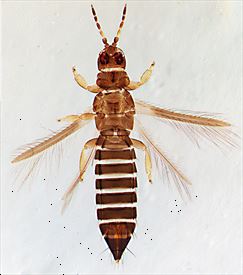
Female

Antenna
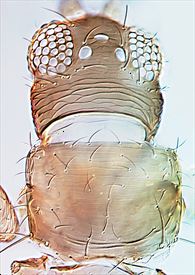
Head & pronotum
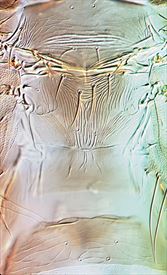
Meso & metanotum

Thoracic furcae
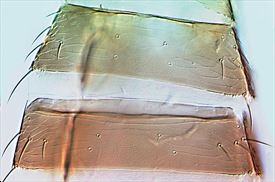
Tergites II-III
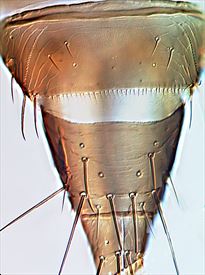
Tergites VIII-X
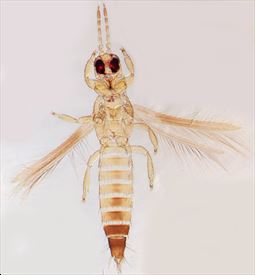
Male
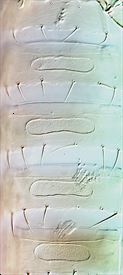
Male sternal pore plates
Distinguishing features
Female macroptera. Body generally brown, with head and thorax paler than darker abdomen; legs mainly yellow but all femora shaded with light brown; major setae brown; antennae mainly brown but III almost yellow; fore wing light brown but slightly paler near base. Head slightly wider than long, cheeks rounded; ocellar setae III about as long as distance between posterior ocelli, arising just outside anterior margins of triangle; ocellar setae II and postocular setae III sub-equal and much longer than postocular setae I. Antennae 7-segmented, segment I with no dorso-apical setae; III and IV with apices slightly narrowed, each bearing a forked sense cone. Pronotum with faint transverse lines of sculpture, 2 pairs of long posteroangular setae, 3 pairs of posteromarginal setae. Mesonotal campaniform sensilla present, median setal pair in front of posterior margin. Metanotum closely striate, median setal pair not at anterior margin, campaniform sensilla present. Fore wing first vein with 3 distal setae; second vein with about 10–14 setae. Prosternal ferna complete medially; mesofurca with spinula, metafurca with no spinula. Tergite II with 4 lateral marginal setae; tergites with a sculpture line between median setal pair, but no lines posterior to this; posterolateral margins of tergites with a few and variably weak craspedal microtrichia; V–VIII with paired ctenidia, on VIII posteromesad to the spiracle; VIII with complete comb; IX with 2 pairs of campaniform sensilla, median dorsal setae stout, almost reaching posterior margin. Sternites and pleurotergites with no discal setae; sternite II with 2 pairs of posteromarginal setae, III–VII with 3 pairs, median pair on VII arising in front of margin.
Male mainly yellow with terminal abdominal segments brown; mesofurcal spinula present; metanotum with paired campaniform sensilla; tergite VIII posterior margin with an irregular, short comb; broad pore plates present on sternites III–VII.
Related species
The genus Stenchaetothrips currently includes 41 species, all associated with Poaceae and all originally from the Old World tropics. Only seven of these 41 species have been reported to have a spinula on the mesofurca, although Bhatti (1982) has indicated that presence of this structure is variable in tenebricus (from Tamil Nadu), and rare in biformis (the Rice Thrips). A mesofurcal spinula is present in spinalis (from The Philippines) and spinulae (from India), and both of these species were collected from bamboo. However, neither of them have campaniform sensilla on the metanotum, in contrast to martini.
Biological data
Found in rolled leaves of the Asian plant, Phyllostachys aurea [Poaceae, Bambusoideae], the fishpole, or walking stick bamboo. Recorded in Britain from an unidentified species of bamboo attributed to the genus Pleioblastus.
Distribution data
Although described from New Zealand, this thrips is clearly introduced from somewhere in southeast Asia, because the host plant is native to Southeast China. Both sexes were collected in February and March, 2016 at Muriwai, 20km West of Auckland, where a population appeared to be well established. However, this species was recorded from England under the name spinalis Reyes, and is also known from south western France.
Family name
THRIPIDAE, THRIPINAE
Species name
Stenchaetothrips martini Mound, Gunawardana & Li
Original name and synonyms
Stenchaetothrips martini Mound, Gunawardana & Li, 2017: 296
References
Bhatti JS (1982) Revision of the Indian species of Stenchaetothrips Bagnall. Oriental Insects 16: 385–417.
Mound LA, Gunawardana DN & Li DM (2017) A new species of Stenchaetothrips (Thysanoptera, Thripidae) from Bamboo, based on morphological and molecular data. Zootaxa 4323 (2): 295–300.